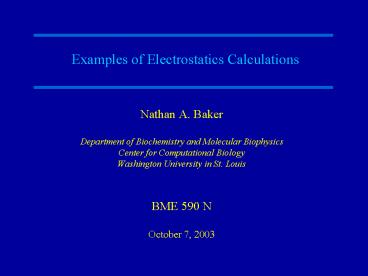Examples of Electrostatics Calculations - PowerPoint PPT Presentation
1 / 9
Title:
Examples of Electrostatics Calculations
Description:
... Calculations. Nathan A. Baker. Department of Biochemistry and Molecular Biophysics ... cglen 100 100 100 fglen 50 50 50. cgcent mol 1 fgcent mol 1. chgm ... – PowerPoint PPT presentation
Number of Views:97
Avg rating:3.0/5.0
Title: Examples of Electrostatics Calculations
1
Examples of Electrostatics Calculations
- Nathan A. Baker
- Department of Biochemistry and Molecular
Biophysics - Center for Computational Biology
- Washington University in St. Louis
- BME 590 N
- October 7, 2003
2
Examples
- What well cover
- Ion solvation
- Ion-ion PMFs
- Ionic screening
- Ion condensation
- Ligand binding
- What we wont cover
- Protein-protein interactions
- pKa calculations
- Force evaluation/dynamics
3
What the user tells APBS
- Molecule input and calculation data
- Solver method
- Grid specifications
- Resolution
- Length
- Center
- Charge discretization
- Version of PBE to solve
- Boundary conditions
- Mobile ion species
- Charge
- Concentration
- Radius
- Dielectric values
- Solute value
- Solvent value
- Surface definition
- Apolar coefficient
- Temperature
- read
- mol pqr mol.pqr
- end
- elec
- mg-auto
- mol 1
- dime 97 97 97
- cglen 100 100 100 fglen 50 50 50
- cgcent mol 1 fgcent mol 1
- chgm spl0
- lpbe
- bcfl mdh
- ion 1.0 0.150 2.0 ion -1.0 0.150 2.0
- pdie 2.0
- sdie 78.54
- srfm smol srad 1.4 swin 0.3
- temp 298.15
- gamma 0.00072
- calcenergy yes
4
The Born ion
- Simple ion model
- Non-polarizable sphere (e1), embedded point
charge, high dielectric medium outside - Analytical expressions known for potential and
energy - This example
- Calculate electrostatic potential
- Calculate solvation energy
- Software
- APBS (http//agave.wustl.edu/apbs/)
- Gnuplot (http//www.gnuplot.info/)
5
Ion-ion potential of mean force
- Two-ion PMF
- Illustrates reaction field effects
- Continuum description of desolvation
- This example
- Calculate desolvation energies from PBE
- Calculate direct interactions from Coulombs law
- Software
- APBS (http//agave.wustl.edu/apbs/)
- Gnuplot (http//www.gnuplot.info/)
6
Ligand binding energies
- Balanol and protein kinase A
- Part of a investigation of selectivity of kinase
inhibtors - See
- Wong CF, et al. J. Med. Chem. 44 1530-1539,
2001. - Hünenberger PH, et al. Biochemistry 38
2358-2366, 1999. - Used PB and SASA methods
- Ranked inhibitor binding (??G)
- This example
- Calculate electrostatic potential for complex,
PKA, and balanol using PBE - Calculate binding energy
- Visualize interaction of balanol potential with
PKA binding site - Software
- APBS (http//agave.wustl.edu/apbs/)
- VMD (http//www.ks.uiuc.edu/Research/vmd/)
7
Non-specific ion interactions screening
- Mouse acetylcholinesterase electrostatics
- Hydrolyzes acetylcholine
- Diffusion-limited reaction rate
- Highly-sensitive to ionic strength
- This example
- Calculate electrostatic potential for AChE using
PBE - Look at 1 kT/e isocontours at 0 mM and 150 mM
NaCl - Implied effect on binding rate
- Simulations of binding rate
- Software
- APBS (http//agave.wustl.edu/apbs/)
- VMD (http//www.ks.uiuc.edu/Research/vmd/)
8
Non-specific ion interactions condensation
- Examine DNA 36-mer (B form)
- Look at NaCl condensation (typical of other
cations as well) - 67 of ions at 17 Å
- This example
- Calculate electrostatic potential for DNA in 100
mM NaCl - Convert to charge density
- Visualize charge density contours
- Software
- APBS (http//agave.wustl.edu/apbs/)
- VMD (http//www.ks.uiuc.edu/Research/vmd/)
9
Computational Electrostatics State of the Art
- Computational methods have varying strengths and
weaknesses - Usually trade efficiency for accuracy
- Implicit solvent methods
- Much faster than explicit approaches
- In the ??G regime (at best) for prediction
- Very sensitive to model and parameters
- Poor treatment of ion effects
- Explicit solvent methods
- More accurate ?G-quality predictions
- Only as good as the force field
- Very slow limited by rate of sampling

